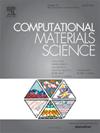High-Precision identification and classification of alloy fatigue microcracks through deep learning and in-situ SEM
IF 3.1
3区 材料科学
Q2 MATERIALS SCIENCE, MULTIDISCIPLINARY
引用次数: 0
Abstract
The formation and propagation of microcracks are critical stages leading to fatigue failure. Traditional methods for microcrack analysis essentially rely on manual detection, which poses challenges in accuracy and efficiency. The present investigation deals with a novel and highly effective strategy for detecting, classifying, and analyzing fatigue microcracks in Ti-6Al-4 V (TC4) titanium alloy with artificial intelligence (AI) in the context of deep learning. By integrating in-situ scanning electron microscope (SEM) images and convolutional neural network (CNN) algorithm, we propose a PGI-CrackNet model that is able to detect microcracks of length around 15 μm and thereby effectively outperform the detection capabilities of traditional models. Based on fracture mechanics models, the proposed model is capable of automatically identifying the main stages (i.e., initial crack, type I crack, type II crack, and break) in the formation of microcracks. Simultaneously, the proposed model bridges the gap between the AI-based image analysis and the physical crack propagation models, enabling the extraction of key information such as microcrack length and width, and further supporting the analysis of fatigue crack growth rates associated with various microcrack stages. The model could discover that in the initiation stage, the crack of TC4 titanium alloy grows at a fairly slow rate (∼3.6 μm/cycle) and occupies most of the crack life cycle. After the initiation stage, the crack first propagates as the type I cracks with a significantly faster crack growth rate (∼50 μm/cycle). Then, the type II crack occurs with a substantially reduced growth rate (∼25 μm/cycle). In the final stage, as the microcrack reaches a critical size, the growth rate increases sharply, leading to break. In summary, this improved PGI-CrackNet-based model enables more accurate tracking of crack growth over the fatigue life of materials and better classification of crack types based on their propagation mechanisms, making it highly suitable for early warning applications of material failure.

求助全文
约1分钟内获得全文
求助全文
来源期刊

Computational Materials Science
工程技术-材料科学:综合
CiteScore
6.50
自引率
6.10%
发文量
665
审稿时长
26 days
期刊介绍:
The goal of Computational Materials Science is to report on results that provide new or unique insights into, or significantly expand our understanding of, the properties of materials or phenomena associated with their design, synthesis, processing, characterization, and utilization. To be relevant to the journal, the results should be applied or applicable to specific material systems that are discussed within the submission.
 求助内容:
求助内容: 应助结果提醒方式:
应助结果提醒方式:


